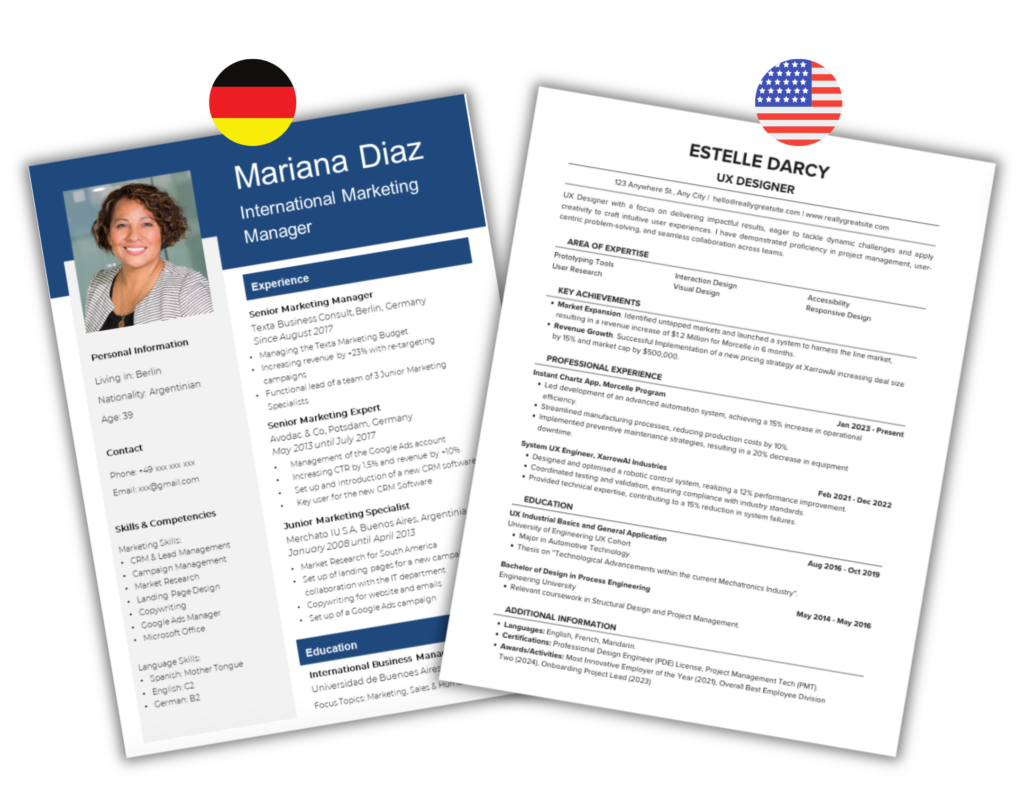When applying for jobs in different countries, tailoring your CV or resume to the local standards is crucial. Both the U.S. and Germany have distinct expectations when it comes to the presentation of your qualifications and experience. By understanding these key differences, you can create a tailored application that improves your chances of landing an interview. In this post, we’ll compare the German and American CV formats and highlight what you need to pay attention to when applying in each country.
Let’s analyze the key differences

1. Personal Information and Privacy
🇩🇪 Germany: When applying for jobs in Germany, personal details such as your address, phone number, and a professional photo are standard inclusions. While Germany has strict anti-discrimination laws, including this information is not seen as a breach of privacy. Moreover, recruiters in Germany encourage having a professional photo on the CV. They expect a more holistic view of the candidate. Leaving them out may raise questions for potential employers.
🇺🇸 United States: In the U.S., the situation is quite different. Providing personal information such as age, gender, or a photo is not only unnecessary but is discouraged due to anti-discrimination laws. American companies are legally bound to avoid making hiring decisions based on personal characteristics. As a result, resumes typically focus solely on professional qualifications and achievements. Including unnecessary personal details might even get your application disqualified in some instances.
What to Pay Attention To: If you’re applying for a job in Germany, include the expected personal information and a professional, high-quality photo. If you’re applying in the U.S., stick to professional details and avoid sharing anything that could potentially lead to bias.
2. Layout and Structure
🇩🇪 Germany: In Germany, the CV is often structured in a two-column format. This layout helps organize information efficiently, allowing the recruiter to easily navigate between different sections. Typically, the left column is narrower and used for personal information, technical, interpersonal, and language skills, and additional qualifications like courses and certificates. The right column is wider and contains more detailed information, such as professional summary, experience, and education. It is crucial to provide exact dates for each job, including both the month and year. German employers value continuity and precision in employment history, so gaps in employment should be clearly explained, whether due to further education, parental leave, or personal development.
🇺🇸 United States: In the U.S., resumes are often structured in a slightly different order. There is usually one column. Work experience usually comes first, followed by education, and then skills or certifications. Many American resumes now include a summary or objective statement at the top, highlighting key qualifications and goals. Unlike German CVs, U.S. resumes rarely provide exact dates for job positions. Instead, they typically include the duration or just the years (e.g., “2018–2020”).
What to Pay Attention To: For German applications, ensure you include precise dates and avoid any gaps in your career timeline. For U.S. resumes, feel free to keep dates less specific, and consider including a summary statement if it adds value to your application.
3. Focus on Skills vs. Experience
🇩🇪 Germany: In Germany, the CV provides as much detail as possible for each job position. For each role, you should include around 5–6 bullet points that describe your responsibilities and tasks in-depth. Gaps in employment must be explained, whether they were due to further education, personal reasons, or travel. German recruiters expect a clear, continuous career timeline without unexplained periods of inactivity.
🇺🇸 United States: In contrast, U.S. resumes focus less on job tasks and more on key achievements. Bullet points should highlight quantifiable accomplishments rather than detailed daily responsibilities. This allows for a more streamlined resume, with fewer bullet points per position. Additionally, U.S. applicants are encouraged to omit unrelated experiences, such as working as a waiter/waitress, if it doesn’t align with the role they are targeting.
What to Pay Attention To: When applying in Germany, focus on providing a detailed overview of your job responsibilities, leaving no employment gaps unexplained. For U.S. resumes, highlight measurable achievements and omit experiences that don’t contribute directly to your career goals.
4. Tone and Language
🇩🇪 Germany: German CVs are formal and fact-focused. Employers value modesty and professionalism, and candidates are expected to provide a straightforward account of their qualifications and experience without exaggeration or self-promotion. The focus is on precision and clarity rather than personal flair.
🇺🇸 United States: In the U.S., resumes tend to be more self-promotional. American applicants are encouraged to highlight their achievements and to describe their qualifications dynamically and engagingly. The tone can be more casual compared to German CVs, and phrases like “results-driven” or “proven track record” are common.
What to Pay Attention To: When applying in Germany, stick to a formal, factual tone that emphasizes professionalism. For U.S. applications, feel free to use more dynamic language that sells your personal brand.
Conclusion: Comparing a CV for Germany vs the US
Understanding the differences between German and American CVs is essential for tailoring your application to meet the expectations of employers in each country. In Germany, precision, detail, and a formal tone are valued, while in the U.S., brevity, impact, and self-promotion are more important.
By aligning your CV with the specific job market requirements in each country, you can significantly improve your chances of making a strong impression and securing that all-important interview.
If you are looking for a German CV template, feel free to download our free template here.




